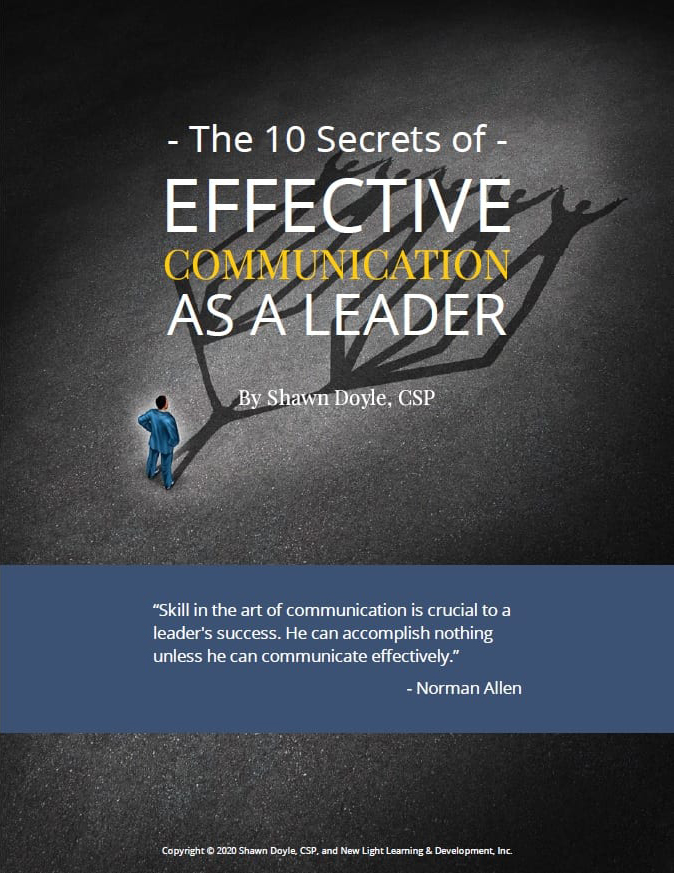Blog

True Leadership: Have a Mission and Vision Statement
One of the critical elements of successful leadership is having a mission and vision statement for the organization, the team, and even for individuals. I see many organizations that have their mission and vision statements proudly displayed on marble plaques in their lobby. They use it as a signature at the end of each email. Some of these leaders follow those mission vision statements and values. In other organizations the mission and vision just take up space on the wall. They truly have no meaning. When you ask employees what the mission and vision statement of their organization is, some can recite the mission and vision statement verbatim, while others look like a deer caught in headlights, or mumble like Dustin Hoffman in Rainman.
Before we delve further into an in-depth discussion about mission and vision statements, we need to look at the definition of mission and vision. More importantly, we need to find out what it really means. The official Webster’s dictionary definition for mission is: A pre-established and often self-imposed objective or purpose.
There are a few interesting aspects to note. One element of the definition is pre-established. This means that there has been some forethought and that thinking went into the establishment of a mission. Secondly, I think that the wording of self-imposed is notable. This clearly indicates that the creation of a mission is a proactive activity as opposed to a reactive activity. The last two important key words in the definition are objective and purpose. Obviously, in business, there must be objectives to meet. Objectives enable us to make sales, increase profitability, and increase cash flow. Clearly, then, mission vision statements do help organizations reach goals by establishing and “self-imposing them.”
We also need to look carefully at the definition of vision, which is, “The act or power of imagination, the mode of seeing or conceiving, or unusual discernment or foresight.”
Notice the acknowledgement of the power of imagination and the use of the word foresight. Isn’t it true that great leaders should have a powerful imagination and great foresight? Didn’t Walt Disney? Steve Jobs? Mary Kay? If we can agree that great leaders must have the ability to meet objectives and purposes as well as having imagination and foresight, or the ability to look at the big picture, then we can all agree that mission and vision is extraordinarily valuable to the success of a leader.
To clarify mission and vision just a little more clearly, the mission and vision statement is the perfect combination. The mission is “where we are” and the objectives that we’re going to achieve. The vision is what we’re striving to achieve long-term or “where we’re headed.” In my consulting practice, I have seen companies that are extraordinarily successful because they have a well-articulated mission and vision and because they’re passionate about putting it into action.
As a bonus, many organizations also add to the mission and vision statement a list of values. Often, there are between four and seven of them, and each is defined. This list of additional information allows the organization to hold specific values sacred to hold employees accountable and to embody them in the day-to-day operation of the company. Often you see on this list words like integrity, honesty, ethics, creativity, challenging work, family appreciation, etc. The hope is that the employees connect to the list and for them to know that they’re working for an organization that shares their values.
The Benefits of M/V Statements
M/V statements are valuable. Here are five benefits to having them.
- Increased Focus: In a fast-paced corporate environment, it is particularly important to help us stay focused. I have seen many employees who came to a company energized about both the work and the opportunity. However, these employees often become jaded when they find out that the great company that they signed up to work for doesn’t really have a focus. When properly executed, M/V statements allow both the organization and the team to be remarkably focused on future objectives.
- Increased Morale: In all the organizations I have seen, those which have well-articulated M/V statements have significantly higher employee morale than the employees who work for a company without them. Why is that? Having them allows the team to have a rallying cry around something. It’s analogous to a sports team having a cheer, or a person going on a trip having a map. When people are excited about their future possibilities because they know the objectives, their organization morale goes up. When they do not know about objectives, and therefore, are unclear about the future, morale can dip and stay there.
- Enhanced Decision Making: The ability to make decisions is easier if the team can refer to the M/V. If an employee must make an immediate decision about a customer, product, or procedure, they can refer to the M/V and ask themselves, “Does this tie in with our mission? Will it help us move closer toward our long-term vision?”
- You Will Become the Employer of Choice:Companies who have strongly defined M/Vs tend to attract smarter, more enthusiastic, and overall better candidates. Certainly, Toyota, Virgin, Starbucks, Microsoft, Zappos, and Disney are splendid examples of multinational companies that have a truly clear M/V. As a result, they have amazing employees.
- Strategic Clarity: When companies have specific M/Vs they’re able to have clarity around developing and executing a strategy. This is because they can ask themselves, “Is this strategy aligned with M/V or not?” It forces them to look at strategy through different lenses.
What to Do if You Already Have One
If you already have an M/V statement somewhere within your organization, then you’re one step ahead. So, what now? I think the first step to take is to ask some fundamental questions about your current M/V statement as well as your values.
- Where is it? If your organization has one, where is it? I’m not talking about necessarily physically where it is, but where it is in terms of being adopted and indoctrinated into the fabric of the organization? I have seen many organizations that have them printed on glossy paper or woven into the annual report. But that is as far as they’ve gotten. No one in a leadership role is actualizing it. Having an M/V statement sitting in a drawer of each employee, never referred to or acted on, and never having influenced how the company is run has absolutely no value. In fact, it might as well not even exist. As a leader, you really need to look at and assess where you are in terms of the status of the organization as relates to the M/V. I once worked with an organization as a consultant that already had in place a beautifully written and articulated M/V statement. It had been developed at corporate headquarters, but the team members in the field did not know about it and decided to create their own. To make matters worse, within the division there were over a dozen separate areas, and each area had their This created this situation where the team did not feel like a team, because, to use a sports analogy, players were not playing from the same playbook and, in fact, all had different plays. They could not figure out why they didn’t feel like a team.
- Who Knows it? As a leader, it’s especially important to identify who knows about the M/V statement. Is it known about at headquarters, at the divisional level, or at an individual office level?
- Is it Operational? Are the M/V and the values operational? Quite simply, this is asking if the words, ideas, and values expressed are being put into the operational elements of the organization. This is something you need to determine. On a score of 1 to 100, how well would say the organization “operational-izes” the M/V statement? I recently stayed at the Red Rocks Casino and Resort in Las Vegas, Nevada. I must say that I found the resort to be impressive in many ways, including how the employees acted towards me as a guest, the condition of the property, and the unique design of the architecture, which was clearly designed to provide an amazing positive customer experience. When I arrived in my room, I noticed a small table placard sitting on top of one of the dressers. At the top of it was the statement “A 3” in bold letters. Below that, it said: “Welcome to the Red Rocks Resort and Casino. Our mission is A 3, which means any time, any place, anywhere. As a guest of our hotel, tell us what you need – any time, any place, anywhere, and we will make it happen.” I thought this was brilliant because it is obviously tied to their mission of customer service. They were articulating A 3 both to their guests and employees at the same time.
Translating Mission and Vision and Values
I often see situations where M/V and values statements are developed at headquarters, but because the local employees are not involved, they are disconnected from it. An employee in the North may be disconnected because the M/V statement was created in the South in a glass office building. Whose fault is that? First, it’s obviously the fault of the organization for not communicating and driving it throughout the organization, but perhaps the person even more at fault is the leader at the local level. It is up to leaders at the local level to translate the M/V and values from an international to national level to a local level where it makes sense and has relevance.
First, let’s look at the corporate and national M/V. If this already existed, did it in exist in writing? Perhaps you can download it from the corporate website. You can also ask corporate communications or human resources if it is available on posters, coffee mugs, mouse pads, etc. In many cases, M/Vs are rolled out and lots of great promotional materials are created but are sitting somewhere in storage. Find out if any exist and how you can get them. It is now up to you to make sure that everyone knows and understands the M/V and values from corporate – and knows them well. Once this is in place, well understood, and communicated, you’re ready to move to the next level.
Next, look at the division or area M/V. Should the division or area M/V be the same as the national one? I’m of the belief that the M/V on a divisional or area level should be the same or similar. However, it does not hurt to customize for a divisional or area location. What is damaging is when for a division or area it is completely different. That makes the division or area seem like a separate company and is not creating a feeling of a team on a national level. We may legitimately ask at this point, “If I work in the western part of the country, why does it matter that my employees feel like they’re part of a national team? All that should really matter is the fact that they feel like they’re part of our regional or area team, right?” Well, smart question but I couldn’t disagree more. Most employees want to feel like they’re part of something larger, greater, and bigger than them. People want to feel like they belong to something. They take pride in affiliation. When people feel like they belong to something larger, the greater good, they tend to be more productive and have a higher level of morale and pride.
When you have the division and area M/V in place, it’s well understood and well communicated, then you’re ready to move to the next level – which is often ignored and misunderstood.
Next look at the team M/V. The leader (working with the national and divisional or area M/V) works to craft a team M/V. Let’s use the example of the marketing department. A marketing department may not be specifically connected to the national M/V statement. So, the goal of the leader who heads up the marketing department should be to create an M/V statement which aligns with and compliments the national mission and vision. Let’s say I own a cellular phone company. For this example, let’s say that our mission and vision is:
Big Bang Biz (B3) Communications delivers world class service with world class technology for smart customers and in the future will be the source for providing communication products and services worldwide.
Notice that there is not a specific reference woven into the national M/V statement specifically related to marketing. So, it would then be up to marketing to create an M/V statement which helps support world-class service and technology serving world class customers. Now we have an M/V statement that is specific and relevant for that department and for that team. This also eliminates the attitude of, “Hey, why bother? This has nothing to do with me.” Once the team M/V statements are in place, understood, and well-articulated, you’re ready to go on.
Now, what the smart leader will do is translate the M/V statement to individual performance and contributions. So, every employee review will contain a segment which will score the employee in their job performance against the national M/V, the area M/V, and the team M/V. When individuals are held accountable to contribute to objectives and a future view of the organization, then it seriously it will no longer be just a “piece of paper.” It is up to you as the leader to decide how much weight that should have in an employee review process. Honestly, if it’s not part of the review, then M/V and values really don’t have much relevance or importance within the organization.
Leading the Mission and Vision
Here are five tips for making sure as a leader that you’re leading the mission and vision:
- Live it: here is something that shocks many of the participants that I teach in leadership programs. Employees in their day-to-day activities are watching you as a leader in everything that you say and do. Hence, leaders need to be very aware of their behaviors and their actions because they should be role modeling the tenants and philosophies behind the M/V. They should always also be modeling the values. If this does not happen, there’s a huge philosophical disconnect and that is not great leadership. Its dishonest leadership. Because of this, you must be constantly aware of your behavior and modeling what you want your employees to always emulate.
- Communicate it Frequently: in one organization I used to work for, every meeting was started by a reading of the corporate credo. This was not just an empty exercise. It was read with reverence and respect and served as a reminder to every employee as to the M/V and values of the organization. This is a splendid example of frequency of communication relating to the topic. As a leader, you must figure out how to frequently tie specific business situations back to the M/V and values to reinforce them and to teach them. There are many effective communication methodologies that can used to continuously communicate the mission and vision. Speeches and meetings, newsletters, websites, email signatures, and printed materials can all be used to reinforce aspects of the M/V and values in their entirety. I have seen leaders use various communication tools to constantly reinforce the message over time so that it eventually becomes woven into the fabric of the organization.
- Push It: most of the great leaders that I see around the country are constantly pushing the M/V statements. On specific projects, they ask, “How does this relate to our M/V?” They’re always looking for ways to push, reinforce, remind, and bring forth the importance and relevance of the M/V. This helps employees to find ways to apply it to their work.
- Hold Others Accountable to it, too: great leaders hold the employees accountable to the M/V and values. That means that when they’re reviewing the results of a project, they’re asking that specific employee if the project reflects the true M/V of the organization.
- They Weave into the Fabric of the Organization: as leaders work on different projects, they constantly strive to weave the M/V and values into everything that they do. If they’re giving a speech to a group, they will mention it If they’re working on a project, they figure out to weave a reference to the M/V into the project. The goal, of course, is to get the team to a place where they start telling the stories and reinforcing the M/V and values the same way that the leader does. That is when it becomes part of the culture.
Want to be effective as a leader? Get clear on the mission and lead the way!
Want to learn more about how to be a great leader? Read Shawn Doyle’s book, Jumpstart Your Leadership.







